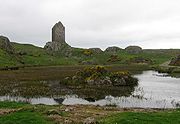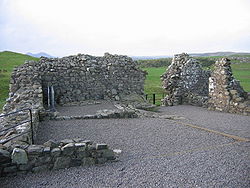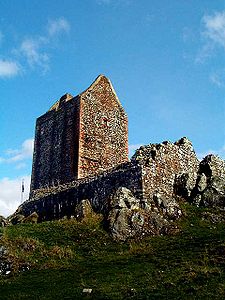
Smailholm Tower
Encyclopedia

Peel tower
Peel towers are small fortified keeps or tower houses, built along the English and Scottish borders in the Scottish Marches and North of England, intended as watch towers where signal fires could be lit by the garrison to warn of approaching danger...
at Smailholm
Smailholm, Scottish Borders
Smailholm is a small village in the old county of Roxburghshire in south-east Scotland. It is situated at and straddles the B6397 Gordon to Kelso road. The village is almost equidistant from both, standing 6 miles NW of the abbey town of Kelso...
, around five miles (8 km) west of Kelso in the Scottish Borders
Scottish Borders
The Scottish Borders is one of 32 local government council areas of Scotland. It is bordered by Dumfries and Galloway in the west, South Lanarkshire and West Lothian in the north west, City of Edinburgh, East Lothian, Midlothian to the north; and the non-metropolitan counties of Northumberland...
. Its dramatic situation, atop a crag of Lady Hill, commands wide views over the surrounding countryside. The tower is located at grid reference , just west of Sandyknowe farm, and is now a Scheduled Ancient Monument
Scheduled Ancient Monument
In the United Kingdom, a scheduled monument is a 'nationally important' archaeological site or historic building, given protection against unauthorized change. The various pieces of legislation used for legally protecting heritage assets from damage and destruction are grouped under the term...
in the care of Historic Scotland
Historic Scotland
Historic Scotland is an executive agency of the Scottish Government, responsible for historic monuments in Scotland.-Role:As its website states:...
. In June 2007 it was awarded the maximum "five-star" status as a tourist attraction from VisitScotland
VisitScotland
VisitScotland is Scotland's national tourism agency. It is a public body, with offices in Edinburgh, Inverness, London as well as other parts of Scotland...
, a rating bestowed on only eight other sites in Scotland.
History

Clan Pringle
Clan Pringle is an Armigerous clan from the Scottish Borders.-Origin of the Name:According to the detailed book 'The Records of the Pringles', published by Alexander Pringle in 1933, the surname Hoppringill, or Pringle, dates from the reign of Alexander III of Scotland and is one of the oldest...
. This family, originally spelt Hoppringle
Clan Pringle
Clan Pringle is an Armigerous clan from the Scottish Borders.-Origin of the Name:According to the detailed book 'The Records of the Pringles', published by Alexander Pringle in 1933, the surname Hoppringill, or Pringle, dates from the reign of Alexander III of Scotland and is one of the oldest...
, who were followers of the Earl of Douglas
Earl of Douglas
This page is concerned with the holders of the extinct title Earl of Douglas and the preceding feudal barons of Douglas, South Lanarkshire. The title was created in the Peerage of Scotland in 1358 for William Douglas, 1st Earl of Douglas, son of Sir Archibald Douglas, Guardian of Scotland...
, held the lands of Smailholm from the early 15th century, and managed part of Ettrick Forest
Ettrick Forest
Ettrick Forest is a former royal forest in the Scottish Borders area of Scotland.It is a large area of moorland, south of Peebles, stretching from Dollar Law to Selkirk.-See also:*James Hogg*Craik Forest*Wauchope Forest...
for their feudal superior.
Smailholm Tower was designed, in common with all Scottish peel towers
Peel tower
Peel towers are small fortified keeps or tower houses, built along the English and Scottish borders in the Scottish Marches and North of England, intended as watch towers where signal fires could be lit by the garrison to warn of approaching danger...
, to provide its occupants with protection from sporadic English raids
Border Reivers
Border Reivers were raiders along the Anglo–Scottish border from the late 13th century to the beginning of the 17th century. Their ranks consisted of both Scottish and English families, and they raided the entire border country without regard to their victims' nationality...
. The tower was attacked by English soldiers in 1543, 1544 and again in 1546, when the garrison of Wark Castle sacked the tower and carried off prisoners and cattle. The castle was successfully defended against the English in 1640, by Sir Andrew Ker of Greenhead.
Smailholm was obtained by the Scotts of Harden around this time. The Scotts – ancestors of Sir Walter – rebuilt parts of the tower and barmkin. In the 18th century the tower decayed, following the family's move into nearby Sandyknowe. The last owner, the Earl of Ellesmere
Earl of Ellesmere
Earl of Ellesmere, of Ellesmere in the County of Shropshire , is a title in the Peerage of the United Kingdom. It was created in 1846 for the Conservative politician Lord Francis Egerton. He was granted the courtesy title of Viscount Brackley, of Brackley in the County of Northampton, at the same...
, handed the property into state care in 1950. It was restored in the 1980s, and now operates as a museum.
The tower

Barmkin
Barmkin, also spelled barmekin or barnekin, is a Scots word which refers to a form of medieval and later defensive enclosure, typically found around smaller castles, tower houses, pele towers, and bastle houses in Scotland, and the north of England. It has been suggested that etymologically the...
, or courtyard.
The rectangular tower is of four storeys, situated on top of a rocky outcrop. The tower is approximately 12.1 m by 9.4 m, with basalt rubble walls 2.4 m thick. The vaulted basement was originally divided into two floors by a wooden éntresol reached by a ladder. The door is on the south side, in a large red sandstone arch, with the turnpike stair in the south-east corner. Above the vault is the hall, with a fireplace to the north featuring a carved human face.
The top floor has an unusual elliptical stone vault which supports a stone flag roof. Parapet walks run along the longer north and south sides, although both are interrupted – the north by a chimney and the south by a window. These upper parts of the tower, including a gunloop in the west gable covering the barmkin, were remodelled in the 17th century.
The tower is surrounded by the remains of a stone barmkin wall, within which the ruins of outbuildings and a small chapel are still visible. The east part of the barmkin once contained a small garden, all of which is now gone. The western barmkin is more intact, with walls up to first floor level around the narrow entrance in the west wall. The courtyard, around 16 m by 19 m, contains the foundations of a single-storey hall house of the 17th century to the north, and a two-roomed kitchen block to the south.
A ditch protects the western approach to the tower, the other three sides being naturally protected by the face of the outcrop. One hundred metres to the southeast, more earthworks mark the presence of a much older settlement, probably dating from the first millennium BC.
Smailholm Tower is now used to display an extensive array of model people illustrating the history of Smailholm and the stories of Walter Scott, a display created by two local artists and employing high-quality embroidery and modelling techniques. From 2006, experiments were conducted on the roof to establish the most suitable damp-proofing method to apply to other such properties, including the planting of turf or mats of sedum plants. As a result of this, a restoration project in 2010/11 reinstated a turf roof over the entire structure.
Sir Walter Scott
The tower provided inspiration to Sir Walter ScottWalter Scott
Sir Walter Scott, 1st Baronet was a Scottish historical novelist, playwright, and poet, popular throughout much of the world during his time....
, who visited his paternal grandfather here when still a boy. Scott spent considerable time at the tower during his youth, reportedly for the benefit of his health. Smailholm provides the setting for Scott's ballad The Eve of St John, and also appears in Marmion. As a result of Scott's poetry, his uncle restored the tower, making it safe, around 1800. Turner
J. M. W. Turner
Joseph Mallord William Turner RA was an English Romantic landscape painter, watercolourist and printmaker. Turner was considered a controversial figure in his day, but is now regarded as the artist who elevated landscape painting to an eminence rivalling history painting...
visited Smailholm with Scott in the author's later years; his sketch of the tower was included in Scott's Poetical Works. Turner's journey with Scott traced scenes from Marmion, and not long after this, the pioneer of photography Fox Talbot repeated Turner's itinerary, publishing what is considered to be the first photographic travelogue or tourist coffee-table book, Sun Pictures in Scotland in homage to both Scott and Turner.
See also
- Clan PringleClan PringleClan Pringle is an Armigerous clan from the Scottish Borders.-Origin of the Name:According to the detailed book 'The Records of the Pringles', published by Alexander Pringle in 1933, the surname Hoppringill, or Pringle, dates from the reign of Alexander III of Scotland and is one of the oldest...
- Brotherstone HillBrotherstone HillBrotherstone Hill is a hill near St. Boswells and the Eildon Hills in the Scottish Borders area of Scotland, with two standing stones from the megalithic age, on the summit of Brotherstone Hill, at a height of 243 metres. The stones differ in height and stand 16 metres apart...
- SmailholmSmailholm, Scottish BordersSmailholm is a small village in the old county of Roxburghshire in south-east Scotland. It is situated at and straddles the B6397 Gordon to Kelso road. The village is almost equidistant from both, standing 6 miles NW of the abbey town of Kelso...
- List of places in the Scottish Borders
- List of places in Scotland
- Castles in ScotlandCastles in ScotlandThis list of castles in Scotland is a link page for any castle in Scotland.A castle is a type of fortified structure built during the Middle Ages. Scholars debate the scope of the word castle, but usually consider it to be the private fortified residence of a lord or noble...

